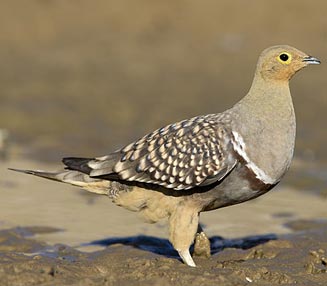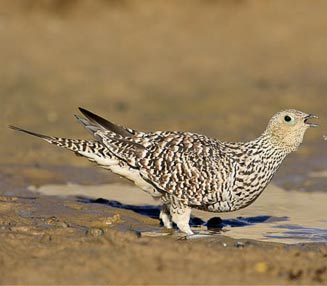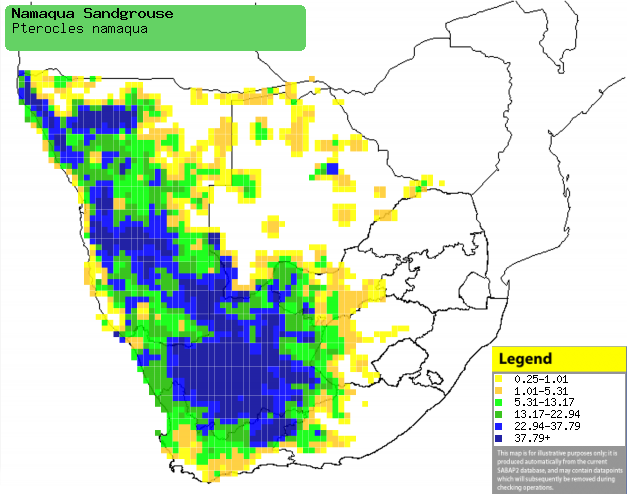|
Pterocles namaqua (Namaqua
sandgrouse)
Kelkiewyn [Afrikaans]; Simbote (generic term for
sandgrouse) [Kwangali]; Kokoi [South Sotho]; Setlatlawe sa namakwa [North
Sotho]; Lekotokobii, Lekwętękwię [Tswana]; Namaqua-zandhoen [Dutch]; Ganga
namaqua [French]; Namaflughuhn [German]; Cortiçol da Namáqua [Portuguese]
Life
> Eukaryotes >
Opisthokonta
> Metazoa (animals) >
Bilateria >
Deuterostomia > Chordata >
Craniata > Vertebrata (vertebrates) > Gnathostomata (jawed
vertebrates) > Teleostomi (teleost fish) > Osteichthyes (bony fish) > Class:
Sarcopterygii (lobe-finned
fish) > Stegocephalia (terrestrial
vertebrates) > Tetrapoda
(four-legged vertebrates) > Reptiliomorpha > Amniota >
Reptilia (reptiles) >
Romeriida > Diapsida > Archosauromorpha > Archosauria >
Dinosauria
(dinosaurs) > Saurischia > Theropoda (bipedal predatory dinosaurs) >
Coelurosauria > Maniraptora > Aves
(birds) >
Order: Charadriiformes > Family: Pteroclidae
 |
 |
| Namaqua sandgrouse male, Kgalagadi
National Park, South Africa. [photo
Johann Grobbelaar ©] |
Namaqua sandgrouse female, Kgalagadi National
Park, South Africa. [photo
Johann Grobbelaar ©] |
Distribution and habitat
Near-endemic to southern Africa, occurring from
south-western Angola through Namibia to patches of Botswana, the Northern Cape
and adjacent provinces. It generally prefers gravel desert, sandy semi-desert,
open dwarf shrubland and sandy savanna, while especially common in the Nama
Karoo and southern Kalahari.
|
 |
|
Distribution of Namaqua sandgrouse in southern Africa,
based on statistical smoothing of the records from first SA Bird Atlas
Project (©
Animal Demography unit, University of
Cape Town; smoothing by Birgit Erni and Francesca Little). Colours range
from dark blue (most common) through to yellow (least common).
See here for the latest distribution
from the SABAP2. |
Predators and parasites
Movements and migrations
Nomadic and partially migratory, as it is
mainly present in Namaqualand and Karoo in summer (September-April)
and in the southern Kalahari it is most common in winter
(May-August)
Food
It mainly eats seeds, especially of protein-rich legumes,
supplemented with flowers, small fruits and fresh leaves. It does most of its
foraging in the day with its head held low, rapidly pecking the ground and
flicking away soil with its beak. The following food items have been recorded
in its diet:
- Plants
- seeds
- Indigofera
- Lotononis
- Tephrosia
- Requernia sphaerosperma (red pea)
- Limeum
- Giseckia pharnacioides (Volstruisduiwe)
- Amaranthus
- Cleome
- Chenopodium
- Lophiocarpus burchelli (Sandaarbossie)
- grasses (Poaceae)
- daisies (Asteraceae)
- fresh leaves
- flowers
- small fruits
Breeding
- Monogamous solitary nester, it is not territorial, with both sexes
selecting the nest site.
- The nest is a simple scrape in the ground, often lined with grit that
builds up over time and typically placed adjacent to a small shrub or grass
tuft.
- Egg-laying season is year-round, peaking from January-May in northern
Namibia, April-July in the Namib Desert (Namibia), June-November in the
Kalahari, August-January in the Nama Karoo and September-February in the
Western Cape.
- It lays 2-3 eggs, which are incubated by both sexes for about three
weeks, with the female taking the day shift while the male incubates at night.
- The chicks are led by their parents to an area with food approximately
12 hours after the last chick hatching, and they quickly learn how to pluck
seeds from the ground. The male makes daily trips to a waterhole so that
he can soak his belly feathers which the young drink from, only stopping
when they reach about two months old. They can fly in short burst at about
30 days old, flying strongly about 12 days later but only becoming fully
independent at least a month later.
Threats
Not threatened, in fact common and widespread, as it has
greatly benefited from the sinking of waterholes. Heavy nest predation and low
productivity in the Nama Karoo is cause for concern however, as its South
African population decreased during the second half of the 20th Century.
References
-
Hockey PAR, Dean WRJ and Ryan PG 2005. Roberts
- Birds of southern Africa, VIIth ed. The Trustees of the John Voelcker
Bird Book Fund, Cape Town.
|
